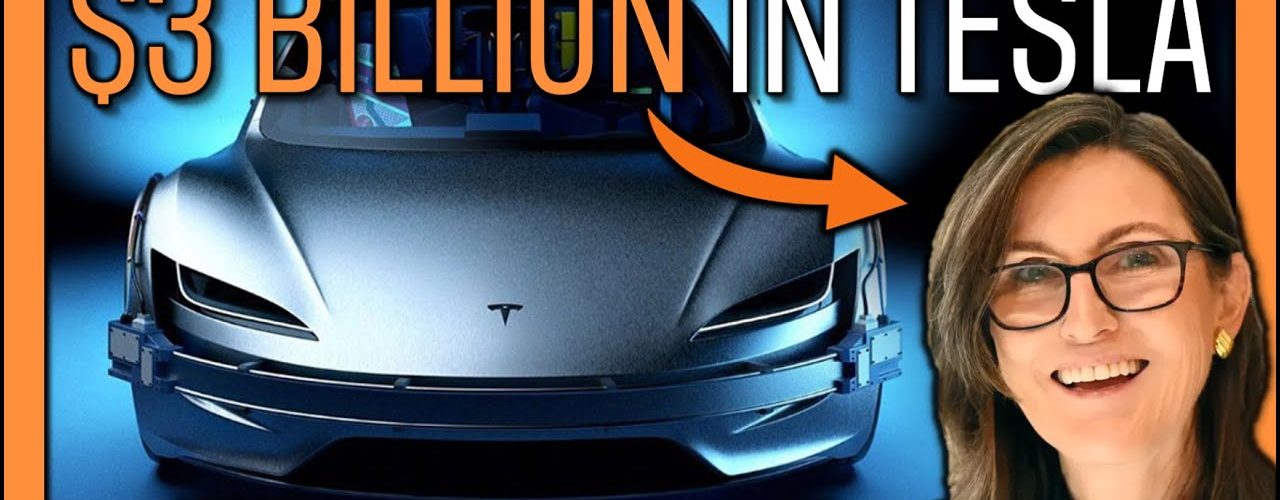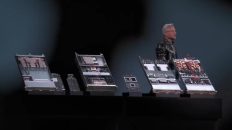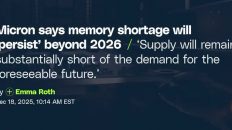Mentioned in Video:
- ARK Invest's Price Target for Tesla in 2025 (Tasha Keeney, ARK Invest): https://ark-invest.com/articles/analyst-research/tesla-price-target-2/
- Mobility-As-A-Service: Why Self-Driving Cars Could Change Everything (Tasha Keeney, ARK Invest):https://ark-invest.com/white-papers/self-driving-cars-white-paper/
- Tesla Should Launch a Human Driven Ride-Hail Service to Accelerate Its Autonomous Strategy (Tasha Keeney, ARK Invest): https://ark-invest.com/articles/analyst-research/tesla-ride-hail-update/
- Tesla Valuation Model: Are Investors Stuck in Reverse? (Tasha Keeney, ARK Invest): https://ark-invest.com/articles/analyst-research/tesla-valuation-model/
- ARK Invest, Tasha Keeney on Tesla and Battery Day (CNN): https://www.youtube.com/watch?v=zwoanP0iH8Y
- Tesla's Future Battery Strategy Explained (@Two Bit da Vinci): https://www.youtube.com/watch?v=g1ppM22EQFs
- Support the channel and get extra member-only benefits by joining us on Patreon: https://www.patreon.com/tickersymbolyou
⚡ #CathieWood has over $3 BILLION in #Tesla stock (#TSLA) across #ARKK, #ARKW, and #ARKQ. @ARK Invest has a $3000 price target for Tesla stock over the next 5 years. Let's see if Tesla is still one of the best stocks to buy now or if Cathie Wood's big bet on electric vehicles is running on fumes
Video Transcript:
[00:00:00.000]
Tesla is reducing battery costs by 50%, increasing range, by over 50% and reducing investment. So the cost built factories by 70%… I mean, if you're a traditional automaker, you must be so scared right now. If you are building an electric vehicle. A lot of auto makers are actually using a different form factor of battery than Tesla. So they couldn't even try to copy Tesla if they wanted to. They actually just have to start with a whole new battery platform. But on top of that, I think it's just going to take, you know, at this point, with Tesla's patents that they have on this new cell structure and architecture, I think that it could be sort of a lifetime advantage that they have over the auto industry.
[00:00:42.150]
I mean, I think it'll be massively difficult to catch them.
[00:00:45.150]
These numbers are a huge 50% reduction in cost per kilowatt hour, 50% increasing ranges. You said the nearly 70% reduction in investment per gigawatt hour. I want to pick you up on what you just said there, because in the past we've discussed this. You've said, look, Tesla's battery technology is what, four years ahead of the competitors are you now saying if and I'm putting a big emphasis on if they can achieve this, then that lead would be insurmountable.
[00:01:13.300]
I think that's exactly what this means.
[00:01:17.160]
Okay, let's add some context here. This is Tasha Keeney, ARK Invest's analyst, focused on autonomous technology and robotics strategy. You may recognize her from such ARK publications as, “Baby, You Can Drive My Autonomous Car”, ARK's Tesla evaluation model from 2019. And, of course, ARK Invest's recently released $3,000 price target for Tesla in 2025. It's currently setting the Internet on fire because it's more than double their 2024 price target of $1400 after accounting for Tesla's five for one stock split. Here, check it out.
[00:01:51.230]
When I thought of this initially, I don't think there's a fund manager in this country. A fund manager in this country that could get away with this kind of thing other than Cathie Wood. And I say that because if it were a brokerage house that came out and said this, David, we would dismiss it so quickly as being hype. But Cathie Wood actually is so good that you start thinking, okay, well, what is Elon Musk gonna do? I mean, maybe he's got a lot in mind that she's thought about.
[00:02:21.780]
I always know that Elon Musk wants to reinvent the entire grid. The entire grid, which, remember, was put together in Peaceville. When I heard it this week. And I spent a lot of time trying to figure out how she got to that price target. Okay, and? I just think that she's using the notion that Elon Musk is going to be able to make cars everywhere.
[00:02:45.360]
So on one end, we have Jim Cramer who didn't read it. And on the other end, we have Christopher Bloomstran, who read into it, maybe a little too much. He went on a 34 tweet storm focused exclusively on the insurance piece of the price target. Yikes.
[00:02:59.430]
Actually, I'm not even mad. That's amazing.
[00:03:02.150]
Of course, insurance is by far the smallest contributor to this price target, contributing about $60 to it. The only reason I'm surprised ARK Invest included it in the model is because it contributes 2% to the overall expected price, which is less than Tesla's stock moves in a typical trading day. So they opened up this whole extra can of worms they just didn't have to. Instead, let me open up my own can of worms by highlighting some of the assumptions and omissions from this price target, showing you how to read its results and then tying everything back to ARK Invest's Big Ideas.
[00:03:34.090]
Like Jim Cramer aptly pointed out, this model doesn't account for the energy storage or solar sides of Tesla's business, which Elon has said could be bigger than Tesla's automotive side one day, especially if you account for the software side of that utility business, like Auto Bidder. It doesn't account for anything related to Project Dojo, Tesla's supercomputer designed for machine learning training, which Elon has said Tesla could launch as a web service. And finally, they've included nothing about all of the software, subscription and microtransaction revenues that Tesla might unlock after solving full selfdriving, since nondriving passengers will be captive audiences and Teslas have multiple in car screens: think gaming, streaming, custom playlists tailored to you, the length of your drive, the things you might be passing by, and so on.
[00:04:21.370]
After all, Tencent, ticker symbol TCEHY owns 5% of Tesla. Heck, Tesla might even offer snacks for long enough trips. We wanted flying cars, but Tesla might end up giving us the airplane experience on the ground instead. All jokes aside, my point is that I'm surprised to see no mention of all of the in car revenue streams that Tesla would unlock if they solved selfdriving, given that a major component of this cost model is specifically assuming they do solve it and scale out their robotaxi network by 2025.
[00:04:53.540]
And that brings me to the three big assumptions. And boy, are they big. First, ARK's previous 2024 valuation model assumed a 30% chance of delivering autonomous driving by 2024. This new model now says that's 50% by 2025. I'm not saying this jump from 30% to 50% in just one year isn't justified. There are serious improvements being made in artificial intelligence, machine learning, and computer vision every year. I'm just pointing out that that this is a big jump. The second assumption is that human driven ride hailing could add $20 billion to Tesla's operating profit in 2025, even though that service doesn't exist today.
[00:05:36.100]
The human ride hailing portion contributes about $500 to this price target, which is a pretty meaningful amount even in the bull case. And third, this article says that they're assuming 60% of Tesla's vehicles equipped with autopilot will be robotaxis, but the model actually states it's 60% of all of Tesla's vehicles. So by 2025, up to three in five of all Teslas will be robotaxis in the bull case. For every 10% that's off, you take off $450 from the price target. So if ARK is absolutely right on everything except only two in five Teslas, which is still over 10 million cars, are fully operational robotaxis in just five years, the model the price target is still $900 lower just from changing that one number.
[00:06:29.830]
And don't forget, this also assumes that laws and regulations everywhere allow autonomous fleets like this in the first place. The reason it's important to call out all of these assumptions is because that's what the colors mean in this scenario mix that ARK Invest provides. You read this by drawing a vertical line from the top plot through the bottom plot. So for example, if I draw a line from the expected value down through the scenario mix, I can see that roughly half of the cases that resulted in the $3000 price target include Tesla meaningfully scaling robotaxis. With all of those assumptions, we just talked about another 35% of the cases that resulted in this price
[00:07:10.330]
have Tesla doing human driven ride hailing with all of the assumptions in that section, but not Robotaxi. And the last 15% or so is Tesla producing more than 4 million vehicles that year, but not transition conditioning a meaningful amount of them to ride hailing. When you move this line left or right, you're changing the mix of scenarios contributing to the price target above the line. The bear case has a 60% likelihood that there's no ride hailing service of any kind, roughly 35% chances of human-driven ride hailing and only 5% for Robotaxis.
[00:07:44.650]
The bull case almost entirely relies on scaling out the fleet of robotaxis in the next five years. When I was back at MIT, I often heard this quote by the late George Box, a famous statistician: “all models are wrong, but some are useful”. No spreadsheet can predict the future, not even the ones built by ARK Invest who are genuinely excellent at researching, understanding, and highlighting it. So let's take a step back and focus on what makes this Tesla evaluation model useful. ARK Invest has a very different approach to thinking about technology and the way it's shaping the world, and this model is a reflection of that view.
[00:08:21.730]
That vision is what this channel is really focused on exploring. ARK holds over three and a half billion dollars in Tesla today. All of these numbers and spreadsheets and scenarios show us the high and low ends that they see for Tesla's growth over the next five years. By the way, I'd love to hear your thoughts on Tesla's future too. Do you think Tesla's energy business will scale in the next five years? Do you think they'll have a mostly autonomous ride hailing fleet by then? Will their primary product still be passenger vehicles or something else entirely?
[00:08:51.980]
Comment below or tweet me your thoughts at Ticker Symbol: You. Now that we have all this context, let's rewind and watch Tasha Keeney's recent interview on CNN again, where she discusses her thoughts on Tesla's recent announcements during 2020s Battery Day.
[00:09:06.040]
You mentioned the $25,000 car. Tesla is reducing battery costs by 50% increasing range, by over 50% and reducing investment. So the cost build factories by 70%. I mean, if you're a traditional automaker, you must be so scared right now.
[00:09:24.190]
I want to pick you up on what you just said there, because in the past we've discussed this. You've said, look, Tesla's battery technology is what four years ahead of the competitors are you now saying if and I'm putting a big emphasis on if they can achieve this, then that lead would be insurmountable.
[00:09:41.240]
I think that's exactly what this means. And the cheaper car is also another point in that bucket, right? Because now if you want to match Tesla on price and performance, how are you going to do that? Traditional autos are really just wasting their time on things like fuel cells, which we know is a much less efficient technology, doesn't make sense from an infrastructure perspective. So they really haven't even gotten their ducks in a row yet on batteries. And now Tesla is just running away from that.
[00:10:12.230]
It's quite fascinating, as if we're talking about a $25,000 entry point. And actually they were saying a fully autonomous Tesla. But we'll skip that bit because I know you get very excited about their advances in the autonomous technology and the data collection, too, because if you look on the lifetime basis of an electric vehicle, it works out cheaper, but it's the entry point, the relative height or the greater cost that's a difficulty for many people here. If you can bring those kind of costs down, then there's a double whammy here, too.
[00:10:41.420]
This is all about the future, and I think that's what investors are focusing on today.
[00:10:45.330]
That CNN clip, which I've linked in the description below, is the perfect piece to clarify the bullishness of ARK Invest's 2025 Tesla valuation. Tesla is coming out with a $25,000 car. That's the car that makes up the majority of the Robotaxi fleet in ARK's valuation model. That's also the mass market electric vehicle that's going to compete with, say, a Toyota Camry, which is the best selling car in the world. That's why Tasha Keeney is saying traditional automakers must be so scared right now, because, as CNN's Julia Chatterley brilliantly pointed out, it's the initial cost of an electric vehicle that's preventing most people from purchasing one right now, even though on a lifetime basis, electric vehicles are cheaper. Here's, that same cost breakdown,
[00:11:28.770]
but now on cost per mile, as you can see, the cost of operating a Toyota Camry are about 50% higher than the Tesla Model 3. And those savings come from exactly the things that come with being an electric vehicle: fuel and energy costs, since electricity is cheaper than gas and maintenance and repairs, since battery electric vehicles have far fewer moving parts. So, how can Tesla get around these big initial costs? Here's a cost breakdown of a Tesla Model 3 that I found in a paper titled Value Chain Analysis and Opportunity by Alex Shutze.
[00:12:01.490]
Remember, these are all models, so they're not perfect, but they are useful. It turns out that the battery pack is the most expensive part of an electric vehicle, followed closely by the interior and the frame. Tesla's roadmap towards a $25,000 car involves lowering the costs of these three big pieces of the pie by keeping the interior fairly simple and minimalistic, as well as by making advancements in manufacturing and by advancing their own battery technology. Here's what Tesla is actually doing. They're stamping out the rear underbody of their new vehicles in a single piece using the Gigapress.
[00:12:35.360]
That means almost 80 fewer parts. Remember, fewer parts means fewer points of failure, which means lower maintenance costs. To do that, they had to create a new aluminum alloy that doesn't need heat treating or coatings. That means fewer manufacturing steps, which means less cost per car. If you didn't know, modern aircraft wings aren't actually wings. They're wing shaped fuel tanks. Fuel literally fills almost the entire wing. This maximizes the amount of fuel the plane can hold while minimizing the amount of metal that does nothing but weigh it down.
[00:13:06.890]
So Tesla is doing the same thing in their cars. They're moving away from battery packs and towards using batteries as part of the car's structure. Combining all these things means about 10% less weight and 14% more range. Oh, yeah, and 370 fewer points of failure. This idea of sell to vehicle integration gets its own slide in ARK Invest's 2021 Big Ideas report because it's a pretty big differentiator. If legacy automakers don't begin integrating their cars and batteries this way, they might never be able to close that 14% range gap.
[00:13:39.360]
Just as Tasha Keeney pointed out. On top of that, the actual batteries themselves are getting better. There's a sweet spot in battery cell diameter between lowering cost and increasing range. So, Tesla is building their new battery cells in that sweet spot. The problem with bigger batteries is that electrons have to travel further to the exit, which is the battery tab. So Tesla came up with a new tablets design that changes how electrons reach that exit. This design is also simpler and has fewer parts, making it cheaper.
[00:14:07.440]
By the way, this tablet design addresses another common complaint that drivers of internal combustion engine vehicles have about switching to electric. Charging time goes from this to this because the electrons can take the same shorter path into the battery as they would falling out of it. This is a huge deal for power draw. There's also important advancements being made in the battery chemistry itself, which will allow batteries to expand a bit without failing and increasing range and, of course, if you're in control of the battery chemistry, you can separate batteries by application and make the most of the resources you have.
[00:14:40.450]
You can use more nickel for high power applications, like moving a lot of mass. You can use manganese with nickel to increase the range for premium vehicles, and you can use lithium iron batteries for cars where cycle life matters more than range, like in Tesla's power packs and the small cars designed for urban areas, all of which doesn't even consider the advancements being made to the Gigafactory assembly lines, the machines that build the machine, there's so much being done there that it deserves its own video, which will happen when I cover automation and industrial robotics.
[00:15:12.030]
Another one of ARK Invest's big ideas. When you put all of these things together, you can make an electric vehicle that costs as much as the best selling car in the world, that's the big idea. And when your vehicle competes on cost, but provides a better mix of performance and range, your vehicle will be the best selling vehicle in the world, electric or otherwise, which lets you further reduce costs.
[00:15:35.040]
How does the ICE industry look like for in the future?
[00:15:38.910]
Well, I don't think they will be an ICE industry long term.
[00:15:42.320]
Yeah.
[00:15:47.220]
I mean, well, I guess there might be, like, a few things that are like, curious thing. There's still, like, some steam engines made somewhere, but they're just basically sort of quirky collectors items. That will be the future of the internal combustion engine car.
[00:16:01.230]
Even if Teslas never go autonomous. This is what traditional automakers are competing with. And when there's such a high demand, they must compete. If you're running on gas, then you're running out of time. This is Ticker Symbol: You. My name is Alex, reminding you that the best investment you can make is in you.
If you want to comment on this, please do so on the YouTube Video Here














